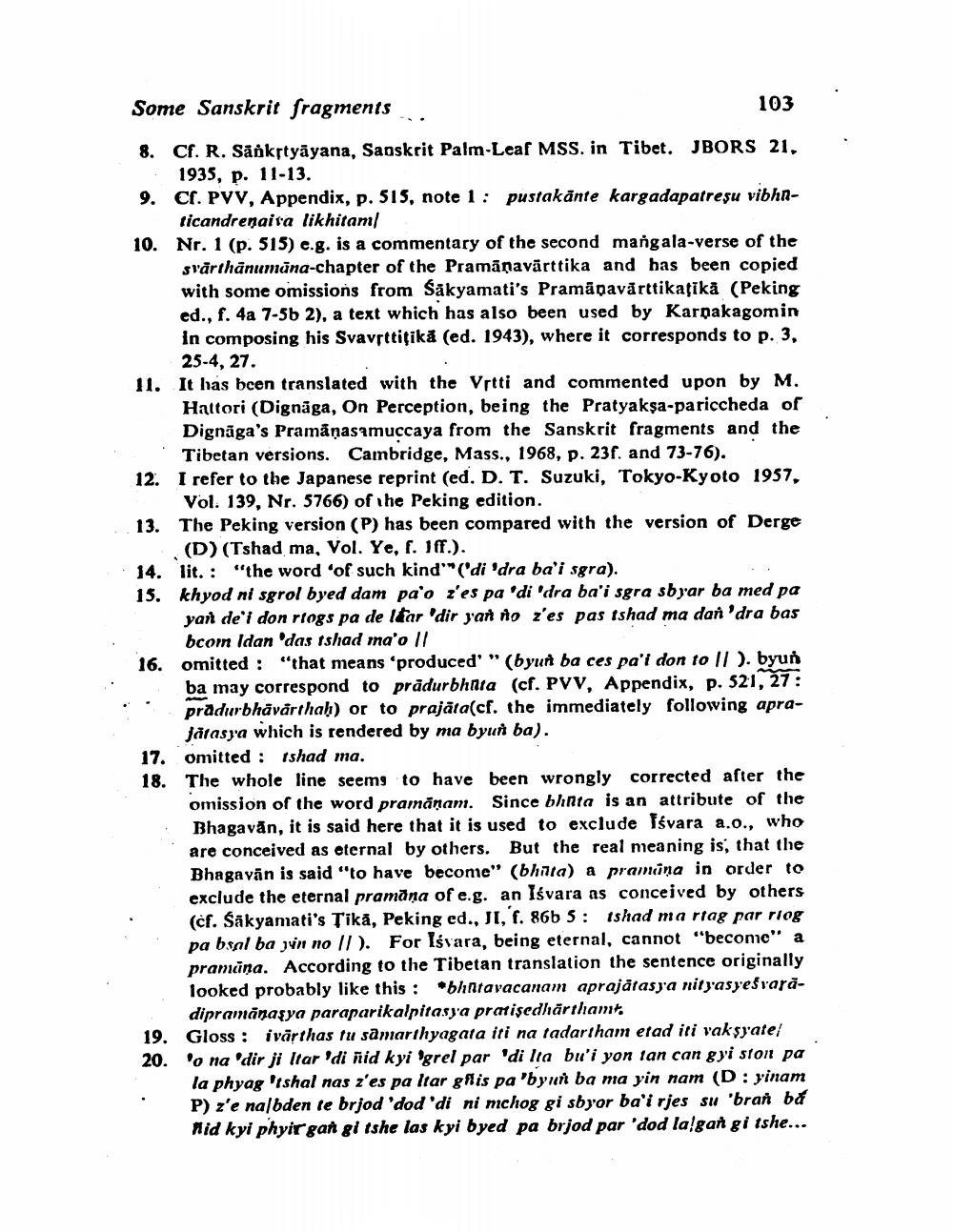Book Title: Sanskrit Fragments Of Jnendrabuddhis Visalamalavati Author(s): Ernst Steinkellner Publisher: Ernst Steinkellner View full book textPage 8
________________ Some Sanskrit fragments 103 8. Cf. R. Sankstyāyana, Saoskrit Palm-Leaf MSS. in Tibet. JBORS 21, 1935, p. 11-13. 9. Cr. PVV, Appendix, p. 515, note 1: pustakānte kargadapafresu vibhn ticandrenaira likhitam 10. Nr. 1 (p. 515) e.g. is a commentary of the second mangala-verse of the svārthānumāna-chapter of the Pramāņavārttika and has been copied with some omissions from Sakyamati's Pramāpavārttikatikå (Peking ed., f. 4a 7-5b 2), a text which has also been used by Karpakagomin in composing his Svavșttiţikå (ed. 1943), where it corresponds to p. 3, 25-4, 27. 11. It has been translated with the Vrtti and commented upon by M. Hattori (Dignāga, On Perception, being the Pratyaksa-pariccheda of Dignāga's Pramåņasımuccaya from the Sanskrit fragments and the . Tibetan versions. Cambridge, Mass., 1968, p. 23f. and 73-76). 12. I refer to the Japanese reprint (ed. D. T. Suzuki, Tokyo-Kyoto 1957, Vol. 139, Nr. 5766) of the Peking edition. 13. The Peking version (P) has been compared with the version of Derge (D) (Tshad ma, Vol. Ye, f. 1ff.). 14. lit. : "the word 'of such kind ('di 'dra ba'i sgra). 15. khyod ni sgrol byed dam pa'o i'es pa'di 'dra ba'i sgra sbyar ba med pa yai de'i don rlogs pa de Itar 'dir yan no z'es pas ishad ma dan'dra bas bcom Idan das fshad ma'o // 16. omitted : "that means 'produced' " (byun ba ces pa'i don to 11 ). byun ba may correspond to prădurbhata (cf. PVV, Appendix, p. 521, 27: pradurbhāvårthah) or to prajăta(cf. the immediately following apra Jätasy'a which is rendered by ma byun ba). 17. omitted : shad ma. 18. The whole line seems to have been wrongly corrected after the omission of the word pramāņam. Since bhnta is an attribute of the Bhagavān, it is said here that it is used to exclude fśvara a.o., who are conceived as eternal by others. But the real meaning is, that the Bhagavān is said "to have become" (bhita) a pramuna in order to exclude the eternal pramāna of e.g. an Isvara as conceived by others (cf. Sakyamati's Tikā, Peking ed., JI, f. 866 5: ishad ma rtag par riog pa bsal ba svin no 11 ). For lśvara, being eternal, cannot "becomic" a pramina. According to the Tibetan translation the sentence originally looked probably like this: bhntavacanam aprajätasya nityasyeśvarădipramănaşya paraparikalpitasya pratisedhartham Gloss: ivärthas tu samarthyagara iti na tadartham etad iti vak syate/ 20. lo na 'dir ji Itar 'di nid kyi 'grel par 'di la bu'i yon tan can gyi ston pa la phyag 'Ishal nas z'es pa ltar gflis pa 'byun ba ma yin nam (D: yinam P) z'e nalbden te brjod 'dod 'di ni mchog gi sbyor ba'i rjes su 'bran bá Nid kyi phyir gan gi ishe las kyi byed pa brjod par 'dod lagan gi ishe... 19.Page Navigation
1 ... 6 7 8 9 10
